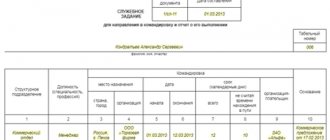You will learn from this article about an individual employee development plan:
- What is an individual employee development and training plan?
- How to determine the goal of an individual employee development and growth plan
- How to create a high-quality employee development plan
- How to chart employee growth
- Structure of an employee development plan
- Example and example of an individual employee development plan
- How to determine the KPI of an employee growth plan
- How to choose a mentor for employee professional development
What is an individual employee development and training plan?
An individual employee development plan is instructions for the personal growth of an employee for a certain period.
In English - Personal Development Plan. Usually it is drawn up for an employee for 6 or 12 months. An individual employee development plan solves 2 problems:
- internal rotation of personnel in the company and their growth. The employer understands that employees are growing. Employee efficiency is increasing. And there are specialists within the company who can replace each other. This is often more convenient than hiring a new employee from outside.
- employees are more actively involved in their work. This document gives the employee projected growth. The employee understands what needs to be learned and how long it will take to get promoted.
In this article, we will teach you how to create an individual employee development plan yourself.
Determining the purpose of drawing up an individual employee development plan
In order for an individual employee development and training plan to work and not just lie on a shelf, you need to draw it up correctly. And in order to draw it up correctly, you need to determine what goals you or your employee want to achieve. Ask yourself, “What would my ideal career look like a year from now?”
Do you want to get a promotion? Or change your specialization? Or go freelance? There can be many options for an employee's goals.
Now you will understand what separates you from your goal. For example, you want to get a promotion. Find out what competencies are needed to fill the desired position.
If you did everything correctly, then now you understand what goal you want to achieve and what separates you from it.
Do you want to accurately determine the goal of an individual employee development plan? Our mentors will help you!
How to organize a knowledge test
Testing knowledge on labor protection is organized according to a specific algorithm
Certification carried out for the first time is organized as follows:
- the administrative document for the enterprise appoints a list of employees who need to undergo such training;
- training is carried out in educational institutions on the territory of enterprises or organizations, as well as outside the territory;
- the OT program is usually designed for 40 hours, it is taught by a teacher who has the right to conduct such training;
- after the knowledge has been acquired, exams should be taken;
- certification can be carried out orally or in the form of testing;
- Based on the results of the certification, a protocol is drawn up and a certificate is issued to the person who successfully passed the exams;
Now you can perform functions assigned by management, including conducting occupational safety training.
Drawing up an individual development plan for an employee: choosing methods
Return to the list of competencies you created in the previous paragraph. Select educational materials for each item.
Google and more experienced comrades will help you. For example, if you are a middle developer and want to become a senior developer, then look for something like “advanced training for middle developers,” conferences for developer employees, courses for employees, textbooks. Collect everything you have chosen into a general list.
Drawing up a schedule for the development and training of a specialist employee
Take the list of methods from the previous paragraph. Distribute them over the period that you set for achieving your goals. Optimal: from 6 to 12 months.
Try not to set very strict boundaries for yourself or your employees. The 2021 pandemic has shown the whole world how any forecasts and agreements can go to hell. Even if they were compiled by specialists. Life in general is full of unpredictability. Don't make your schedule too strict. Let the main deadlines be hard and the intermediate deadlines soft.
For example, dedicate each month to learning one technology from your list. But don't schedule every day of this month hour by hour.
Training of employees in the organization
The following types of training can be roughly distinguished at the enterprise:
- training required for all employees, regardless of position. Such training may include training and testing of knowledge on labor protection;
- training required for certain categories of workers. For example, specialists responsible for organizing labor safety at an enterprise must be trained every three years, and workers directly servicing pressure vessels undergo retraining every year;
- training not provided for by law, to which the employee is sent in agreement with the employer. For example, to improve the qualifications of individual employees, or when transferring to another position.
The employer is obliged to conduct and pay for the first two types of training regardless of his wishes. In these cases, he cannot demand compensation from the employee for the cost of training upon dismissal. In the case when a person is sent for training at the expense of the organization, in agreement with the management, an agreement can be drawn up with him for training the employee with working hours.
The list of mandatory documents that an employer must have does not include a provision on personnel training. Therefore, it can not be drawn up, but a separate chapter in another local regulatory act (Collective Agreement) can be devoted to employee training. But for companies with a large staff, where many different types of training are carried out, it would be more appropriate and convenient to draw up a separate document. It covers the following points:
- what types of training are used in the company;
- frequency of training;
- wages for the days when the employee was studying;
- responsibility for avoiding training;
- procedure for organizing and conducting training;
- which trainings are carried out in-house and which in third-party organizations;
- procedure for training employees at the expense of the company, etc.
We invite you to familiarize yourself with Nutria pet
All employees must be made aware of this provision.
If training is carried out in-house, then the enterprise must develop training programs. You can develop them yourself, or take as a basis those already existing in various guidelines. For example, a sample program for training personnel in occupational safety and health can be found in the document entitled “Approximate program for training in occupational safety and health for employees of organizations” dated May 17, 2004. It is not required, but only recommended for use.
Programs are compiled only for those types of training that the enterprise conducts independently.
Structure of an individual development plan for a professional employee
If you haven't missed anything, then you have:
- Career goals you want to achieve
- Tools and tutorials to help you succeed
- Approximate work schedule
Now put this together into a single structure. You can use anything: notepad, Whatman paper, Excel, mindmap software, Evernote or anything else.
This point should not be skipped or done hastily.
First, when you structure and write down information, it will become organized in your head. Secondly, you will have to work with this document for the next few months. If it is beautiful and comfortable, you will like to return to it and cross out the completed stages. This is important to keep you or your employees motivated.
To create the ideal structure of an individual employee development plan, you should turn to specialists!
Who is responsible for preparation?
Occupational safety is an important component of any technological process, and it is not for nothing that management pays close attention to this. The main person responsible for maintaining this area is the OT engineer. The employer should treat the selection of such personnel with special attention, since the responsibility assigned to them is quite large.
The person responsible for conducting occupational safety training will help you avoid missing deadlines.
All specialists, management, as well as employees of an enterprise or other organizational structure must undergo periodic training.
They can be assigned to any of the employees, for example, an occupational safety specialist or a human resources inspector.
Determine KPIs for an individual specialist development plan
How do you know that you didn’t just read a book or take a course, but that you actually mastered a competency and increased the level of skills of yourself or your employee? You need to introduce performance KPIs. These could be skill tests. Or performing more complex tasks at work. Or creating a personal project. Come up with a format that is more convenient for you or your employee.
The main point is to be honest with yourself. You have already drawn up a growth chart and outlined a trajectory. Cross out items only when you are sure that you have mastered the skill. And not when you finished reading a book or listening to a course.
Education outside the workplace
Studying outside the workplace is considered the most effective. These are frontal classes (lectures), active educational events - conferences and seminars, team work, communication with experts, etc. Let's take a closer look at the main ones.
Lectures
This method is used when it is necessary to quickly convey a large amount of information in a compact form. Lectures are a great way to gain theoretical knowledge where the teaching is conducted by experts. This method has advantages and disadvantages. For example, the lack of feedback and the inability to determine how well students have learned the material; the advantages include low financial costs and the presentation of a large amount of information in a relatively short period of time.
Seminars and conferences
This method is more active compared to lectures, since during the learning process there is the opportunity to collectively discuss various aspects of the topic, thereby improving logical thinking. In addition, unlike lectures, classes are held in small groups; it is possible to analyze complex issues using both the experience of the teacher and the students. Based on the results, an assessment of the effectiveness of personnel training is given.
Business games
The game format involves playing out a situation during which students are asked to solve a given problem.
Trainings
Corporate staff training in a team or training involves setting one task for the group, which they must solve together. To work most effectively with the team, the manager also needs to participate in such classes.
Selfeducation
With this method, the employee independently studies the proposed material. Training takes place in the form of studying audio or video lessons, working with special programs. The advantages of this method include: your own pace of passage, lack of reference to a specific place and time of study, saving money and time. The disadvantages are the lack of control, the inability to ask questions about the material studied, and decreased motivation.
Selecting a mentor to complete an individual development and training plan for an employee
Learning is pleasant, but sometimes difficult. Sometimes you or your employee will get tired, overextended, give up and lose motivation. This happens to everyone.
When an employee grows within the company, he has a mentor. This is usually a more experienced colleague or department head. If you study on your own, you will also have to find a mentor on your own. But we have already done some of the work for you.
Our Solvery platform brings together 175 mentors in 20 areas from large corporations and successful startups. Everyone will find one that suits them. Follow the link and choose a mentor who will lead you to success.
How often do you need to certify?
When drawing up a schedule, it is worth taking into account that certification occurs:
- Planned. Held once every three years. If an employee has not been certified in a timely manner, then he does not have the right to hold a position, as well as to conduct training and instruct workers at his site under his direct supervision.
- Unscheduled. This is a case when an unforeseen incident occurs - an accident, incident or emergency. And also if the employee was appointed to a different position, and it does not matter whether he had certification at that time or not, since the name of the position has changed and the previous knowledge test will not be valid.
We invite you to familiarize yourself with Obtaining Russian citizenship through marriage







